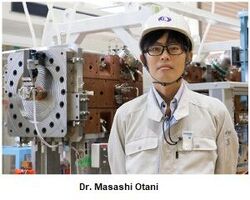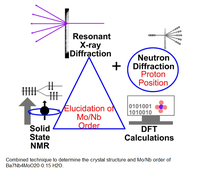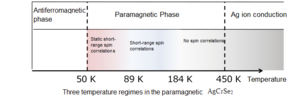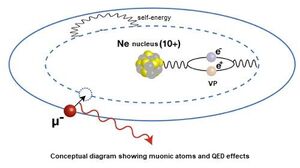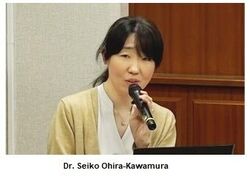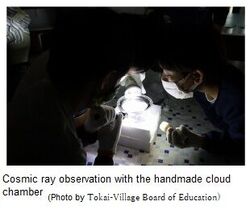J-PARC News June 2023 (Issue #217)
■Resumption of J-PARC Operations (updates)
The operation of J-PARC accelerators,
which had been stopped due to the fire in the power supply building 2 of the main ring on April 25 (Tue), was resumed after safety confirmation of the linac and RCS, and the user program of MLF resumed from May 14 (Sun).
For the main ring accelerator, we are making every effort to take countermeasures.
We apologize for any inconvenience this may cause to you. We appreciate your understanding.
May 24,2023
Takashi Kobayashi, Director, J-PARC center
■Dr. Masashi Otani of Accelerator Division, Receives the Young Scientist Award from the Minister of Education, Culture, Sports, Science and Technology
Dr. Masashi Otani of the Accelerator Division won the Young Scientists' Award for Science and Technology field by the Minister of Education, Culture, Sports, Science and Technology for FY2023 on April 19. Dr. Otani developed a muon accelerator. He demonstrated a new technology that generates negative muonium (pseudo-negative hydrogen ions bound by two electrons and a muon) in a nearly stopped state by bombarding an aluminum target with a muon beam, enabling cooling of the muon energy by three orders of magnitude or more compared to before generation of the negative muonium, and achieved the world's first acceleration of muons in combination with a Radio Frequency Quadrupole (RFQ) accelerator. This achievement is a core technology for next-generation particle research, including precise measurement of anomalous magnetic efficiency (g-2) using a pioneering muon beam with high directionality. The development of acceleration technology is also expected to enable high-resolution imaging technology that surpasses that of cosmic-ray muons.
■Reveal Hidden Chemical Order in disordered "High Ion Conductor Ba7Nb4MoO20" -Clarified by a New Technique Combining Resonant X-ray Diffraction and Solid-State NMR- (April 27)
A research team from Tokyo Institute of Technology, National Institute for Materials Science, Yamagata University, Japan Synchrotron Radiation Research Institute, KEK, and J-PARC Center has developed a versatile new quantitative determination, RXRD/NMR method, which combines resonant X-ray diffraction (RXRD) and solid-state nuclear magnetic resonance (NMR), and elucidated chemical order of hidden molybdates(Mo) in high ion conductor Ba7Nb4MoO20 whose structure is disordered.
Ba7Nb4MoO20-based materials have high oxide-ion conductivity and proton conductivity, as well as high chemical stability. They are expected to be used in solid oxide fuel cells and other applications with large capacity and performance maintained after repeated charge-discharge cycles. On the other hand, such crystalline materials containing multiple similar elements are difficult to study by X-ray and neutron diffraction experiments using single crystals. Therefore, a versatile method to prove the hidden chemical order and disorder in powders and polycrystals has been long awaited.
In this study, by combining the respective strengths of RXRD and solid-state NMR, the team was able to quantitatively determine the chemical order with a high degree of confidence. In Ba7Nb4MoO20-0.15H2O, the chemical (occupational) order of the arrangement of Mo and Nb atoms, which are similar elements to X-ray and neutron, was revealed. Furthermore, neutron diffraction experiments were also used to elucidate the complete crystal structure, including the position of H atoms (present as H+ ions in this material), and it was found that Mo is ordered (localised) near the layers where ions (O2- and H+) conduct, which is related to high ion conductivity.
The knowledge gained from the research result can be used to improve the performance and development of various ionic conductors. In addition, Ba7Nb4MoO20-based materials have potential applications in high-performance fuel cells, oxygen pumps, oxygen sensors, hydrogen pumps, hydrogen sensors, etc.
For more information, please visit the J-PARC website: https://j-parc.jp/c/press-release/2023/04/27001144.html.
■Short-range Spin Correlations in Layered Compound - Three Temperature Regimes Revealed by Muons - (April 27)
A research group from KEK, JAEA, J-PARC Center, and University of Tsukuba has investigated the paramagnetic phase of a layered compound, silver chromium diselenide (AgCrSe2), by muon spin relaxation (μSR) method. As a result, the team showed the existence of short-range spin correlations, revealed their temperature dependence over a wide temperature range for the first time, and found that the paramagnetic phase can be divided into three temperature regions.
Previous quasi-elastic neutron scattering study suggested that the spins in the paramagnetic AgCrSe2 may be correlated, while spins in the paramagnetic phase are generally disordered. However, the results did not give a good picture of the temperature dependence of the phenomena, as it could have originated from other phenomena and the number of measured temperature points was very small.
In this study, μSR experiments were performed at MLF in J-PARC, and μSR spectra were obtained over a wide temperature range in the paramagnetic AgCrSe2. With decreasing temperature, the spectral shape changed from the Gaussian to the exponential curve at about 184 K, and the initial asymmetry decreased sharply at about 89 K. It was revealed that short-range spin correlations of the chromium spins developed below about 184 K, while they did not above the temperature. At temperatures below about 89 K, the short-range spin correlations developed statically. These two characteristic temperatures distinguished three temperature regimes for the paramagnetic AgCrSe2.
The μSR measurements, complemented by neutron experiments at J-PARC, are expected to continue to be a powerful tool for studying spin correlations. The improved understanding of short-range spin correlations may provide an opportunity to develop devices suitable for use at high temperatures in the future.
For more information, please visit the J-PARC website:https://j-parc.jp/c/press-release/2023/04/27001146.html.
■Quantum Electromagnetics Verified with Exotic Atoms -Precise Measurement of Muonic X-ray Energy Succeeded- (May 10)
A research group from RIKEN, JAEA, Tokyo Metropolitan University, Rikkyo University, Kastler Brossel Laboratory, Kavli Institute for the Physics and Mathematics of the University of Tokyo, KEK, J-PARC Center, and Chubu University has successfully succeeded in a proof-of-principle experiment to precisely verify the strong-field quantum electrodynamics with exotic atoms with a transition-edge sensor (TES) detector, a state-of-the-art superconducting X-ray detector, through measuring the energy spectrum of "muonic X-rays" emitted from "muonic atoms" consisting of a negative muon and an atomic nucleus.
One of the most precisely examined theories in physics is Quantum electrodynamics (QED). To verify QED under a strong electric field, where the effect of QED is more pronounced, the team focused on "exotic atoms" in which a heavily charged particle with a negative charge is bound to the nucleus instead of an electron. Among them, QED can be verified under a strong electric field beyond that of multiply charged heavy ions by precisely measuring the energy of "muonic X-rays" using muonic atoms bound by negative muons, which number is maximized at J-PARC. To improve the muonic X-rays' energy resolution by an order of magnitude compared to conventional X-rays, the team introduced TES into the experiment. As a result, the energy of muonic X-rays emitted from muonic-neon atoms was precisely measured, demonstrating the principle of strong-field QED verification experiments using muonic atoms.
Applying this precise measurement method for muonic X-ray energe to elemental analysis methods is expected to open up new research fields, such as isotope analysis and chemical state analysis of elements, which have been challenging to achieve so far. For more information, please visit the J-PARC website:https://j-parc.jp/c/press-release/2023/05/10001151.html.
■J-PARC Hello Science "Neutrons Reveal Microscopic 'Movement' of Materials" (April 26)
Dr. Seiko Ohira-Kawamura from the Neutron Science Section gave the April Hello Science talk. (Dr. Ohira-Kawamura conducts experiments and research by means of the inelastic neutron scattering technique with the cold-neutron disk-chopper spectrometer, AMATERAS.) With AMATERAS, it is possible to study the motion of atoms and molecules by observing how the energy of injected neutrons changes and in which direction they are scattered at a sample. She introduced three research results obtained with this instrument.
1.Development of new cooling technology
At present, vapor compression systems that use gas, such as air conditioners, are the most common, but there are concerns about their impact on the environment. As an alternative new technology, it has been elucidated at the atomic level the mechanism by which a high cooling effect can be achieved in a solid called plastic crystal under pressure.
2.Development of tires made of new materials
The collaboration between AMATERAS, SPring-8, and the "K computer" has elucidated the molecular dynamics in the tire rubber and established technology for developing new tire materials that combine fuel efficiency and safety improvement.
3.Discovery of Hybrid Materials
The study on atomic vibration has led to the discovery of a crystalline material with low thermal conductivity as well as a glass. It is expected for such hybrid materials to be applied to the space industry and other fields in the future.
■Press Salon " Muography for Everything? Multiscale Muon Imaging Extended by Cosmic Rays and Accelerators" (May 18)
This press salon was held online with the participation of 13 members of the press. In this salon, scientists from research institutes and universities gave scientific talks on the development of "multi-scale muon imaging," a new scientific technology with a fusion of various fields, such as science and engineering, by using muons to visualize phenomena on various scales from attometers, 10-18, to kilometers. And the lively discussions took place there. At the end of the salon, the scientists from J-PARC introduced Muon's research on the burial mounds in Tokai Village, which is being conducted in cooperation with the municipal government of the village and others. From J-PARC, Dr.Koichiro Shimomura, Deputy Director of the Material and Life Science Division, and Dr. Masashi Otani, Accelerator Division, participated.
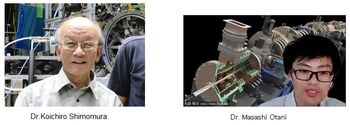 ■Project of Muography for Burial Mounds! "Muography Project to See through Burial Mounds" Started
■Project of Muography for Burial Mounds! "Muography Project to See through Burial Mounds" Started
Finally, the "Muography Project to See through Burial Mounds," called the "Excited for Muon Club," was launched in cooperation with the Tokai-Village Board of Education and the J-PARC Center. The first activity, "Experience Seeing the Invisible: Let's Look at Cosmic Rays," was held on April 30 at the Tokai Village History and Future Community House. There were 18 participants. Please refer to the Tokai-Village homepage for more details. https://www.vill.tokai.ibaraki.jp/soshikikarasagasu/kyoikuiinkai/shogaigakushuka/9/1/2/8270.html
■Sanpo-michi#35 Downgrade of COVID-19's Category to Class 5
J-PARC's public outreach activities have been under various restrictions as a countermeasure against transmitting the new coronavirus. However, the Japanese government downgraded COVID-19 to a category five infection as of May 8, allowing face-to-face activities. On July 1, J-PARC Special Lecture 2023, "The Hyper-Kamiokande Project Finally Begins," will be held. Dr. Takaaki Kajita, Nobel Laureate in Physics, will give a scientific talk entitled "The Mystery of Neutrinos." On the other hand, facility tours and face-to-face outreach activities, such as sending researchers to schools, are also expected to increase.
Over the past three years, the public relations staff has increased outreach through YouTube and Twitter. However, we believe face-to-face interaction with visitors and their understanding of J-PARC is essential to our public outreach. The most enjoyable part of being an explainer is seeing how the visitors react to our explanations and being flexible with the details and expressions. Of course, not all explanations will be convincing, but visitors will give us an idea of what people are interested in and expect from J-PARC. Questions and encouragement from visitors are a wealth of information. We, the public relations staff, are committed to understanding people's interests and expectations through dialogue so that people can better understand J-PARC.
Please feel free to follow us and subscribe to our channel!
J-PARC Channel on YouTube: https://www.youtube.com/channel/UCxaKE2SEegh0qVc1n2PMDaQ
J-PARC twitter: https://twitter.com/J_PARC

